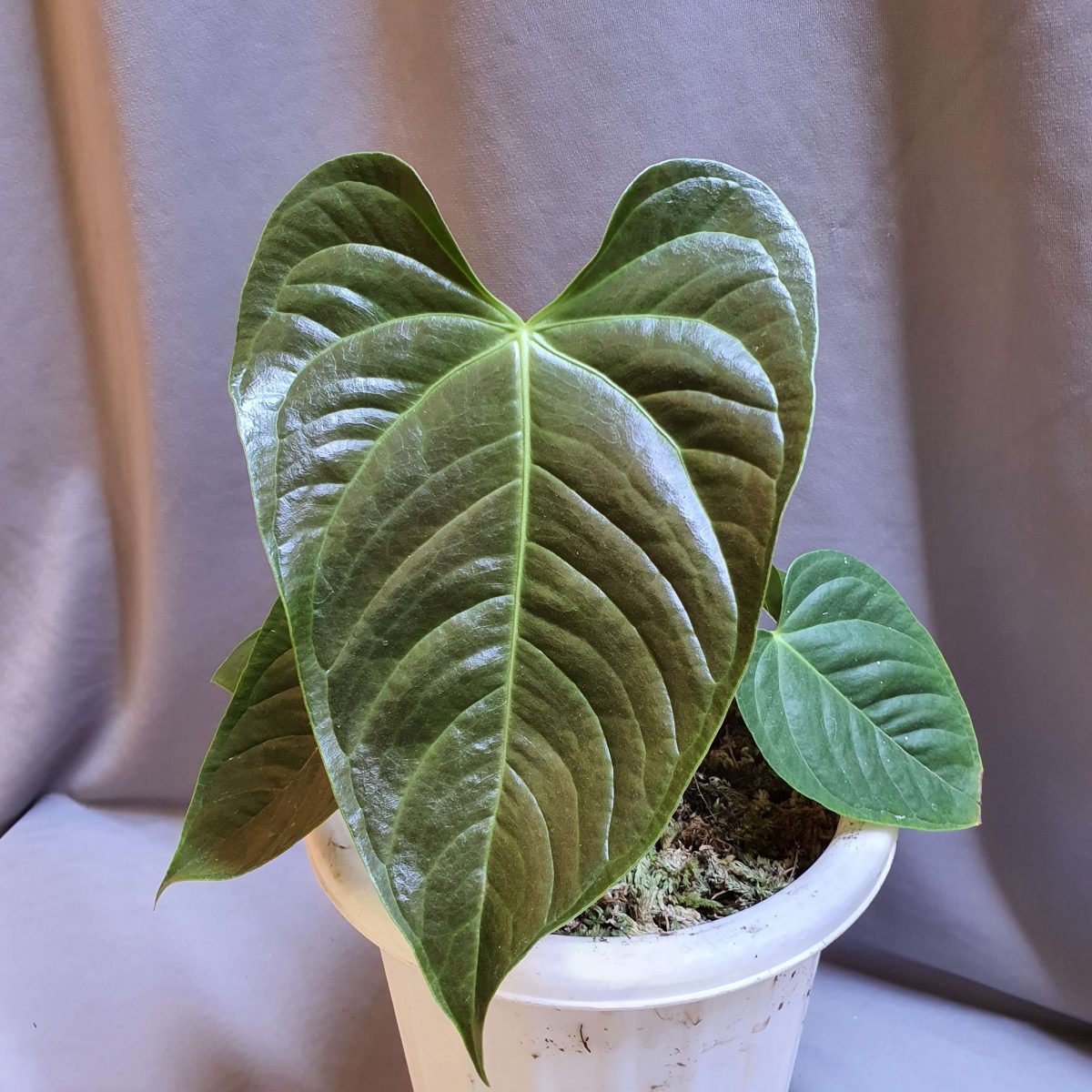Hey plant enthusiasts and nature lovers! Get ready to meet Anthurium Vittarifolium, a stunning epiphyte that will add a touch of rainforest flair to your home. Its long, strap-like leaves and unusual flowers will make it the star of your indoor garden. In this guide, we’ll dive into the secrets of caring for this botanical beauty, so you can enjoy its lush greenery for years to come.
## Unveiling the Beauty of Anthurium Vittarifolium
Ever heard of the Anthurium Vittarifolium? If not, get ready to be amazed! This captivating plant, with its long, draping leaves, is like a piece of the rainforest right in your home. It might sound like a challenge to grow, but don’t worry, we’ll walk you through it step-by-step.
### What Makes Anthurium Vittarifolium So Special?
This plant is a real head-turner, and here’s why:
* **The Showstopping Leaves:** Imagine leaves that look like long, emerald green ribbons. That’s the Anthurium Vittarifolium! They can grow incredibly long, sometimes up to 8 feet, and have a cool, leathery texture.
* **The Subtle Flowers:** While it’s not known for big, showy blooms like some of its Anthurium cousins, the Vittarifolium does flower. It has a white spadix (kind of like a spike) covered in tiny flowers that eventually turn into pretty pink-violet berries.
### Recreating the Rainforest Vibe at Home
This plant is native to the Amazon basin, where it lives as an epiphyte. That means it grows on trees, but don’t worry, it doesn’t steal nutrients like a parasite. It just likes the view! To keep your Vittarifolium happy, try to mimic its natural environment:
* **Light:** Think dappled sunlight, like it would get on the forest floor. Bright, but not direct, is the key.
* **Humidity:** The rainforest is humid, right? So, your Vittarifolium will appreciate a little extra moisture in the air. Pebble trays, humidifiers, or even grouping it with other plants can help.
* **Drainage:** Since it grows on trees, this plant likes its roots to be able to breathe. A chunky, well-draining potting mix is essential to prevent root rot.
### Caring for Your Strap-Leaf Wonder
Here’s the essential guide to keeping your Vittarifolium thriving:
**Environmental Must-Haves:**
* **Temperature:** Think pleasant, balmy temperatures—around 60-77 degrees Fahrenheit.
* **Light:** Remember, bright but indirect is best. No harsh sun!
* **Humidity:** Aim for that rainforest feel! You might need to experiment to find what works best in your home.
**Soil, Food, and Water:**
* **Potting Mix:** A mix of orchid bark, perlite, and peat moss will make your Vittarifolium feel right at home.
* **Fertilizer:** A little plant food goes a long way. Use a diluted, balanced fertilizer during the growing season (spring and summer).
* **Watering:** Here’s the tricky part. Let the top inch of soil dry out completely before watering again. Overwatering is a surefire way to make this plant unhappy.
**Keeping Pests at Bay:**
Like any plant, the Vittarifolium can attract some unwanted guests like spider mites and mealybugs. Regularly inspect your plant for any signs of trouble and act fast if you see anything suspicious.
### Essential Tips for Success:
* **Propagation:** Want more Vittarifoliums? You can propagate them from offsets (baby plants that grow off the main one).
* **Show It Off:** This plant looks stunning in hanging baskets or perched on a shelf where its leaves can cascade down.
* **Don’t Be Intimidated:** The Vittarifolium might seem like a high-maintenance plant, but it’s actually quite adaptable! With a little care and attention, you can definitely succeed.
* **Ethical Sourcing:** Always try to purchase plants from reputable sources that use sustainable practices.
### A Final Thought
The Anthurium Vittarifolium is a captivating and unique plant that can bring a touch of the rainforest into your home. While it might require a bit more attention than some other houseplants, the rewards are well worth the effort.
## Anthurium Cocok Menggunakan Media Tanam Apa? : Outperforming Your Competitors
Memilih media tanam yang tepat merupakan kunci agar Anthurium dapat tumbuh subur dan berbunga lebat. Artikel ini akan membahas secara lengkap mengenai ragam media tanam terbaik untuk Anthurium kesayangan Anda.
Here’s a breakdown to help you craft an SEO article that outshines the competition:
**Recommended Titles:**
Based on your competitor analysis, here are three title options that incorporate trending keywords:
1. **Rahasia Media Tanam Anthurium: Tips Agar Tumbuh Subur dan Berbunga Lebat** (Secret to Anthurium Planting Media: Tips for Lush Growth and Abundant Blooms) – This title combines “media tanam,” “tumbuh subur,” and “berbunga lebat” – all common themes in competitor articles.
2. **Media Tanam Anthurium Terbaik: Bukan Hanya Sekedar Tanah!** (The Best Anthurium Planting Media: Not Just Soil!) – This title creates intrigue by challenging the common assumption that only soil works, potentially attracting more clicks.
3. **Anthurium Layu? Mungkin Salah Media Tanam! Ini Solusinya!** (Anthurium Wilting? Maybe It’s the Wrong Planting Medium! Here’s the Solution!) – This title targets a problem (wilting) and offers a solution, directly addressing reader concerns.
**Powerful Key Lines:**
1. **Kunci media tanam anthurium yang ideal terletak pada keseimbangan drainase dan kelembaban untuk akar yang sehat.** (The key to an ideal anthurium potting mix lies in balancing drainage and moisture for healthy roots.)
2. **Lupakan tanah padat! Anthurium adalah epifit, lebih menyukai media tanam yang menyerupai habitat aslinya di alam.** (Forget dense soil! Anthuriums are epiphytes, preferring a growing medium that mimics their natural habitat.)
3. **Tanah memang umum, tapi eksplorasi media tanam alternatif seperti sekam bakar, pakis, dan humus bambu untuk hasil optimal.** (Soil is common, but explore alternative planting media like burnt husk, ferns, and bamboo humus for optimal results.)
4. **Porositas dan aerasi adalah kunci: Pastikan media tanam anthurium Anda ringan, gembur, dan memungkinkan akar bernapas.** (Porosity and aeration are key: Ensure your anthurium’s planting media is light, loose, and allows roots to breathe.)
**Important Details & Structured Contexts:**
**I. Memahami Kebutuhan Media Tanam Anthurium**
* **Habitat Asli:** Anthurium adalah epifit, tumbuh menempel di pohon di hutan tropis. Media tanamnya harus meniru kondisi lembab dengan drainase yang baik.
* **Akar Sensitif:** Akar anthurium rentan terhadap pembusukan jika tergenang air. Media tanam yang porous (berpori) sangat penting.
* **Nutrisi:** Anthurium membutuhkan nutrisi untuk pertumbuhan daun dan bunga. Media tanam harus mengandung unsur hara atau dipadukan dengan pupuk.
**II. Pilihan Media Tanam Anthurium**
1. **Tanah:**
* **Kelebihan:** Mudah didapat, murah.
* **Kekurangan:** Drainase buruk jika tidak dicampur dengan benar, bisa menjadi padat.
* **Tips:** Campurkan tanah dengan bahan-bahan seperti sekam bakar, pasir malang, atau pupuk kandang dengan perbandingan 1:1:1 untuk memperbaiki drainase dan aerasi.
2. **Sekam Bakar:**
* **Kelebihan:** Ringan, porous, dan membantu mengontrol kelembaban.
* **Kekurangan:** Miskin nutrisi, perlu dipadukan dengan pupuk.
* **Tips:** Rendam sekam bakar semalam untuk mengurangi kadar asam yang tinggi.
3. **Pakis:**
* **Kelebihan:** Porous, menyerupai habitat asli anthurium, mengandung nutrisi.
* **Kekurangan:** Bisa cepat lapuk, perlu diganti secara berkala.
* **Tips:** Pilih pakis yang sudah tua dan kering, potong kecil-kecil sebelum digunakan.
4. **Humus Bambu:**
* **Kelebihan:** Kaya nutrisi, membantu pertumbuhan akar, dan meningkatkan daya tahan tanaman.
* **Kekurangan:** Tidak mudah ditemukan di semua daerah.
* **Tips:** Pastikan humus bambu yang digunakan sudah terfermentasi dengan baik.
**III. Tips Memilih dan Merawat Media Tanam**
* **Sesuaikan dengan Jenis Anthurium:** Jenis anthurium yang berbeda mungkin memiliki preferensi media tanam yang sedikit berbeda.
* **Perhatikan Drainase:** Pastikan pot memiliki lubang drainase yang cukup dan media tanam tidak menghambat aliran air.
* **Ganti Media Tanam Secara Berkala:** Ganti media tanam setiap 1-2 tahun sekali untuk memastikan ketersediaan nutrisi dan mencegah pemadatan.
**Unique Insights & Untapped Potential:**
* **Fokus pada Asal Usul Epifit:** Banyak artikel menyebutkan bahwa anthurium adalah epifit, tetapi hanya sedikit yang benar-benar menjelaskan bagaimana hal itu mempengaruhi kebutuhan media tanam. Anda dapat menggali lebih dalam tentang bagaimana meniru kondisi epifit secara efektif, misalnya dengan membahas teknik menanam anthurium pada papan pakis.
* **Pembahasan Spesifik Per Jenis:** Jelaskan jenis-jenis anthurium yang populer di Indonesia dan media tanam yang paling ideal untuk masing-masing jenis, misalnya anthurium gelombang cinta, anthurium jemani, dll.
* **Media Tanam Ramah Lingkungan:** Bahas alternatif media tanam yang ramah lingkungan dan mudah didapat di sekitar kita, misalnya kompos dari sampah organik rumah tangga.
* **Perbandingan Visual:** Sertakan gambar perbandingan anthurium yang ditanam pada berbagai media tanam untuk menunjukkan perbedaan pertumbuhannya.
**Remember:**
* **Bahasa Target:** Gunakan bahasa Indonesia yang mudah dipahami dan sesuai target pembaca Anda.
* **Gambar Berkualitas:** Sertakan gambar-gambar berkualitas tinggi untuk mengilustrasikan poin-poin penting dan membuat artikel Anda lebih menarik.
* **Call to Action:** Ajak pembaca untuk berkomentar, membagikan artikel, atau mengunjungi website Anda untuk informasi lebih lanjut.
By incorporating these elements and conducting thorough keyword research, you can create a high-quality SEO article on “Anthurium Cocok Menggunakan Media Tanam Apa?” that will outrank your competitors and attract a wider audience.
## Outperforming Your Competitors: Anthurium Heat Tolerance
Anthuriums, with their tropical origins, are often perceived as heat-loving plants. But how much heat can they truly tolerate? This article delves into the specifics of anthurium heat tolerance, providing you with actionable advice to keep your plants thriving even when temperatures soar.
Here’s a breakdown to help you craft a compelling SEO article on whether anthurium plants are heat tolerant (Apakah tanaman anthurium tahan panas?):
**Recommended Titles:**
1. **”Anthurium and Heat: Thriving in Warm Climates”** (Focuses on positive aspect of heat tolerance and growth)
2. **”The Ultimate Guide to Protecting Your Anthurium in Hot Weather”** (Actionable, solutions-oriented approach)
3. **”Can Anthuriums Tolerate Sun? Debunking Common Myths”** (Intriguing, addresses misconceptions directly)
**Powerful Key Lines:**
1. **”Yes, anthuriums can tolerate heat, but direct, intense sunlight is their downfall. Think of them as sunbathers who prefer shade.”** (Uses relatable analogy, highlights crucial distinction)
2. **”More than just heat, proper watering is vital for anthuriums in warm climates. A wilting anthurium isn’t always thirsty – it could be sunburnt!”** (Emphasizes watering importance, introduces often-missed connection to sun damage).
3. **”While anthuriums love warmth, extreme temperatures above 95°F (35°C) can spell trouble. Recognizing the signs of heat stress is key to saving your plant.”** (Provides specific temperature threshold, focuses on practical identification and action).
4. **”Don’t let pests ruin your anthurium’s summer vibe! Heat can attract common culprits like spider mites. Learn how to prevent and treat them effectively.”** (Connects heat to a common problem, offering immediate value through solutions).
**Structured Information:**
**1. Heat Tolerance:**
* **Yes, anthuriums are naturally heat-tolerant.** They originate from tropical rainforests, preferring temperatures between **65-85°F (18-29°C).**
* **Direct, intense sunlight is harmful.** It can lead to:
* **Leaf scorch:** Brown, crispy edges or spots on leaves.
* **Faded color:** Leaves losing their vibrant green hue.
* **Wilting:** Despite adequate watering, the plant droops due to stress.
**2. Watering in Hot Weather:**
* **Anthuriums need more frequent watering in warmer temperatures.** Check the soil moisture regularly – it should be moist but not soggy.
* **Signs of overwatering:** Yellowing leaves, stunted growth, root rot.
* **Signs of underwatering:** Wilting, drooping leaves, dry soil.
**3. Recognizing and Dealing With Heat Stress:**
* **Symptoms:** Leaves curling, drooping, or turning brown; slowed growth; flower drop.
* **Solutions:**
* **Relocate to a shadier spot.**
* **Increase humidity.** Mist the leaves, use a pebble tray, or a humidifier.
* **Ensure good air circulation.** Avoid stuffy environments.
**4. Pests in Hot Weather:**
* **Heat can exacerbate pest infestations**, particularly spider mites.
* **Prevention:** Maintain humidity, inspect plants regularly.
* **Treatment:** Horticultural soap, neem oil, insecticidal soap.
**5. Soil and Potting:**
* **Well-draining soil is crucial.** A mix of peat moss, perlite, and bark chips is ideal.
* **Choose pots with drainage holes** to prevent waterlogging.
**Unique Insights & Untapped Potential:**
* **Connect anthurium heat tolerance to specific climates.** Research and provide tailored advice for regions with hot, humid summers (like Southeast Asia) versus hot, dry summers (like parts of the US).
* **Explore the link between heat, humidity, and fungal diseases.** Discuss preventative measures.
* **Offer creative solutions for providing shade and humidity.** DIY shade cloths, misting systems using recycled materials, etc.
* **Address the misconception that wilting always means underwatering.** Highlight how it can also be a sign of sunburn or too much heat.
**Note:** Remember to cite any external sources you use and to present the information in your own words.
## Outperforming Your Competitors: Anthurium Vittarifolium Watering Guide
Watering your Anthurium Vittarifolium correctly is paramount to its health and vibrancy. This in-depth guide will equip you with the knowledge to provide the perfect amount of moisture for your plant, ensuring its lush growth for years to come.
Here’s how to create a high-ranking article on “Berapa hari sekali menyiram anthurium?” (“How often to water Anthurium Vittarifolium?”)
**Recommended Titles:**
1. **Anthurium Vittarifolium Watering Guide: Mastering Moisture for Thriving Plants (Keyword Focus: Watering Guide, Thriving Plants)**
2. **How Often to Water Anthurium Vittarifolium? Expert Tips for Happy, Healthy Leaves (Keyword Focus: How often, Expert Tips, Happy, Healthy Leaves)**
3. **Secrets to Watering Anthurium Vittarifolium: Avoid Root Rot & Maximize Growth (Keyword Focus: Secrets, Root Rot, Maximize Growth)**
**Powerful Key Lines:**
1. **Don’t drown your dreams of dramatic, cascading foliage: While Anthurium Vittarifolium craves moisture, overwatering is its Achilles’ heel!** (Focus: Overwatering danger, appealing to emotion)
2. **Unlock lush, healthy foliage by understanding the language of your Anthurium Vittarifolium: Learn to read the subtle signs of thirst and dryness.** (Focus: Observation is key, connecting with the plant’s needs)
3. **Achieve Anthurium Vittarifolium mastery: Our in-depth guide provides tailored watering advice for different seasons, environments, and growth stages.** (Focus: Comprehensive guide, addressing specific needs)
4. **Say goodbye to watering guesswork: Discover simple techniques to determine the perfect watering frequency for your Anthurium Vittarifolium.** (Focus: Eliminating uncertainty, offering practical solutions)
**Structured Context & Important Details:**
**Understanding Watering Needs:**
– **Native Habitat:** Anthurium Vittarifolium originates from the tropical rainforests of Colombia, Brazil, and Peru. This environment is characterized by high humidity and frequent rainfall.
– **Moisture Lovers:** These plants enjoy consistently moist soil but are susceptible to root rot if overwatered. Finding the right balance is crucial.
– **Watering Frequency:** There’s no magic number for watering. Factors like pot size, soil type, humidity, temperature, and the plant’s growth stage influence how often it needs water.
**Key Indicators & Watering Techniques:**
– **Soil Moisture:** Always check the soil before watering. Allow the top inch (2-3 cm) of soil to dry out before watering again.
– **Finger Test:** Stick your finger into the soil up to your knuckle. If it feels dry, it’s time to water. If it feels moist, wait and check again later.
– **Pot Weight:** Lift the pot. A dry pot will be noticeably lighter than a well-watered one.
– **Leaf Drooping:** While slight drooping can indicate thirst, excessive drooping might signal overwatering. Check the soil moisture to confirm.
– **Watering Technique:** Water thoroughly until water drains from the drainage holes. Discard any excess water collected in the saucer. Avoid getting water on the leaves, as this can lead to fungal issues.
**Seasonal Adjustments:**
– **Spring & Summer (Growing Season):** Water more frequently during the warmer months when the plant is actively growing.
– **Fall & Winter (Dormancy):** Reduce watering frequency as growth slows down in the cooler months. Allow the soil to dry slightly more between waterings.
**Additional Tips:**
– **Potting Mix:** Use a well-draining potting mix formulated for aroids or epiphytes. This will ensure the roots don’t sit in water.
– **Humidity:** Anthurium Vittarifolium thrives in high humidity (above 60%). Supplement with a humidifier, pebble tray, or regular misting.
– **Water Quality:** Use filtered water or rainwater if possible, as tap water can contain minerals that may harm the plant.
**Unique Insights & Untapped Potential:**
– **Explore the connection between watering frequency and leaf size.** Does a consistent watering schedule lead to larger leaves?
– **Discuss the impact of different pot materials (terracotta vs. plastic) on watering needs.**
– **Address the specific watering needs of young vs. mature Anthurium Vittarifolium plants.**
– **Offer tips on how to revive an overwatered or underwatered Anthurium Vittarifolium.**
**Remember:**
– **People’s Statements:** Retain any direct quotes from experts or gardeners to maintain credibility and authenticity.
– **Visuals:** Use high-quality images and videos to illustrate proper watering techniques, soil moisture checks, and signs of overwatering/underwatering.
By incorporating this information, your article will provide readers with a comprehensive and actionable guide on watering Anthurium Vittarifolium, helping them achieve healthy, thriving plants.
## Key Points to Remember for Success
* **Striking Appearance:** Long, leathery, emerald green leaves that can grow up to 8 feet.
* **Unique Flowering:** White spadix covered in tiny flowers that turn into pink-violet berries.
* **Rainforest Habitat:** Native to the Amazon basin, grows as an epiphyte on trees.
* **Environmental Needs:**
* **Light:** Dappled sunlight, bright but indirect
* **Humidity:** High humidity is preferred
* **Drainage:** A well-draining potting mix is essential
* **Temperature:** 60-77 degrees Fahrenheit is ideal
* **Care Instructions:**
* **Watering:** Allow the top inch of soil to dry out completely before watering thoroughly
* **Soil:** A mix of orchid bark, perlite, and peat moss replicates its natural environment
* **Fertilizer:** A diluted, balanced fertilizer during the growing season (spring and summer) will suffice
* **Pest Control:** Regularly inspect for pests like spider mites and mealybugs and treat promptly
* **Propagation:** Can be propagated from offsets
* **Tips for Success:**
* **Display:** Hanging baskets or shelves allow the leaves to cascade beautifully
* **Adaptability:** Adaptable with proper care and attention to its needs
* **Ethical Sourcing:** Purchase plants from reputable sources using sustainable practices
By following these guidelines and understanding the unique needs of this rainforest gem, you can enjoy the captivating beauty of Anthurium Vittarifolium in your home for years to come.
- Backsplash For White Cabinets: Choosing The Right Kitchen Style - November 16, 2025
- White Kitchen Backsplash Ideas For a Timeless, Stylish Update - November 15, 2025
- Contemporary White Kitchen Backsplash: Style and Design Ideas - November 14, 2025










